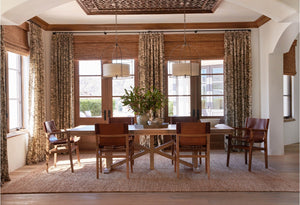
The first time I found myself contemplating kitchen cabinetry choices I was utterly lost! I was still in my twenties and hadn’t yet finished design school when my husband and I embarked on our first remodeling project: a charming 1926 Dutch Colonial fixer upper on the East coast. It was tiny, but it was wonderful– or at least we hoped it could be after the remodel it desperately needed. The last remodel the place had seen was in the 1950s, and it wasn’t long before we had ripped out the old Formica counters, linoleum floors, and knotty pine cupboards and found ourselves looking at our new blank canvas. Our plans included an entire new kitchen and two completely refurbished bathrooms, which I did my best to plot out on graph paper.
Our contractor marked off my layout with tape on the walls and floor and proceeded to ask me what type of cabinets I wanted. My response? “White ones.” He laughed. He said he could build them himself if we’d like, and I remember thinking how lucky we were to have found a contractor that could make cabinets! He started with a small bathroom upstairs, which was lucky, for as much as our contractor tried it soon became clear that cabinet making was not his strong suit. His simple wood box for the sink vanity had two uneven slab doors laid over an equally irregular opening under the sink. These were painted with flat wall paint and outfitted with unsuitably large self-closing hinges that slammed shut with a force that seemed to shake the house every time they closed. So began my crash course in cabinetry!

In the weeks that followed, I started flagging pictures in magazines of kitchens that I liked and taking note of all the details that appealed to me. I visited kitchen design showrooms and custom millwork shops, paying close attention as I learned about overlay versus inset, ready-made versus custom, factory finish versus site finishing. I came to realize that the details I had once overlooked are actually where most of the design impact and utility of a cabinetry package hinge!
Whether ready-made or custom, cabinets are largely constructed in one of two ways: either with their doors and drawers set into the frame (inset) or laid over the frame, partially obscuring it (overlay). Overlay cabinets tend to be seen in more contemporary design. Their hinges are frequently hidden, applied inside the frame for an uninterrupted look. Inset cabinets, on the other hand, have more of the look of a piece of furniture, which is seen often in traditional design. They typically have hinges visibly set into the space between the door and frame. Price can be comparable between the two types of construction, since it is always the case that the more detailed the project, the higher the cost.

The first thing I learned about ready-made cabinets is that there are almost as many cabinet manufacturers on the market as there are furniture brands, and they have as varied a collection of looks and features as you’d expect in furniture. Most kitchen showrooms carry an array of these ready-made cabinet brands: names you might recognize, like Wood-Mode, Quakermaid, Columbia, Downsview, or Crystal Cabinets. Showrooms will either provide installation or allow another contractor to install. Some higher-end cabinet companies like Christopher Peacock and SeiMatic represent their own cabinets and will also insist upon handling their own installation. It’s easy to be confused by the word ‘custom’ when you come across it in a ready-made showroom, since they’ll refer to their cabinets as custom if they are being manufactured for a particular order. In reality, even though they’re tailored to a project, they are still being ordered from a prescribed set of cataloged choices. From door styles to box widths, myriad predetermined selections within the line can be incorporated into your project, as well as options like glass fronts, bead-board paneling, leg styles, pilasters, crown molding, plinth bases... the list goes on. This is where the showroom consultant’s knowledge of the specific brand’s options are key. The artful manipulation of the available choices can result in the most beautiful and functional space. What I like about working with ready-made cabinets is that what you see is what you get. When you see a sample in the showroom, you know that the product that will be installed will have all of the same features as the sample, such as self-closing drawer slides and hinges, laminate interiors, or a long lasting, durable factory finish, and you have a very good idea of what you’ll end up with before you pull the trigger.
True custom cabinetry can be obtained through local cabinet shops, which may also be referred to as mill shops or custom millwork providers. Shops like these build their own cabinets and built-ins for each specific project from scratch. Some mill shops will finish their cabinets in-house, and some will only deliver and install unfinished cabinetry. In the case of the latter, another crew of painters or finishers can be hired to do the finishing on site after the installation. The advantage to using a local custom provider is creative control. Custom cabinetry providers work from shop drawings, which are instructions for the assembly of the cabinetry design. An architect or designer will typically supply these designs to the millworker, though there are some cabinetry shops that will provide these drawings for you. It’s through custom providers like these that I am able to design a very specific look or function to suit any given situation.

Ultimately, for our little Dutch Colonial all those years ago, we chose a ready-made cabinet by Quakermaid. We spent more than we initially thought we would for our cabinets, but in the end we were happy that we had. We bought them through a local lumber company and worked with their kitchen department manager, who was well versed in all the features Quakermaid offered. We chose inset cabinets with a simple shaker door style and a lovely beaded detail around each opening, and to this day, that detail is one of my favorites to incorporate into my cabinet designs. Between glass fronts on some upper cabinets, tongue and groove detailing on the exposed end panels, and a pretty little open fretwork apron on the underside of an upper bookshelf, we made great use of the customization options they provided. All the cabinets were ordered in a durable baked-on ivory painted finish, and I sourced countertops in moss green honed slate.
The end result was a simultaneously simple and beautifully detailed space, perfect for the home and perfect for us. Our kitchen was small, but worked as if it were much larger because each cabinet was ordered for function as well as form. The better part of ten wonderful years were spent in that lovely kitchen, and for all of it I was grateful that I had stopped the presses to learn the ins and outs of cabinetry. It turned out to be one of the biggest decisions we’d made as homeowners at the time, and it laid the foundation of what would become my love affair with cabinetry design.


